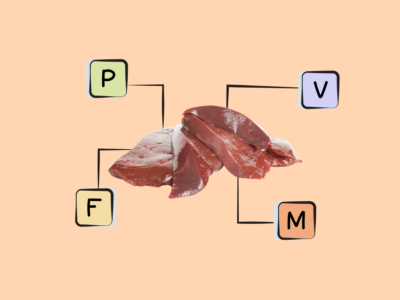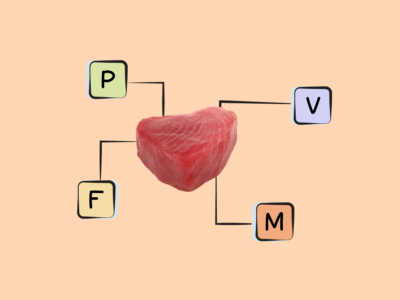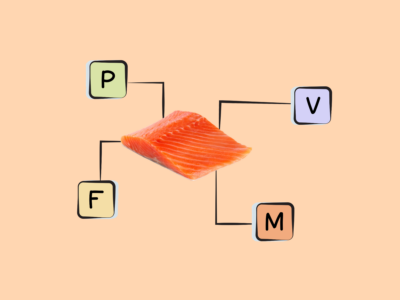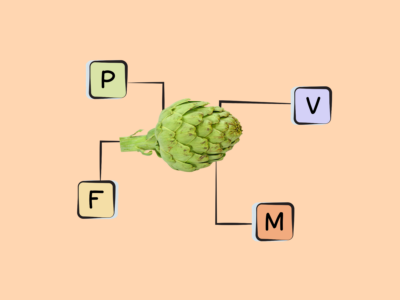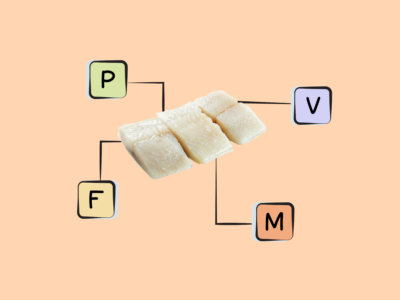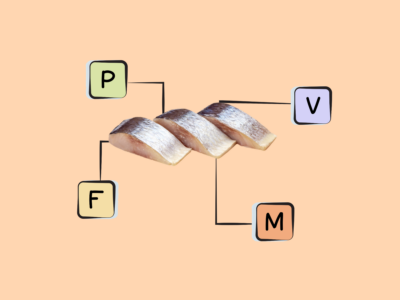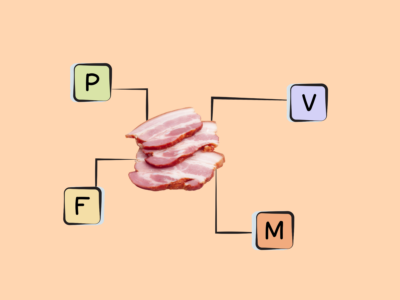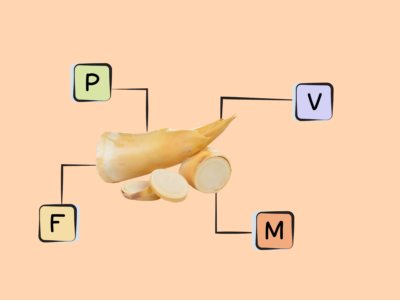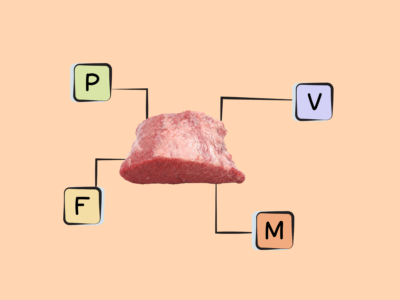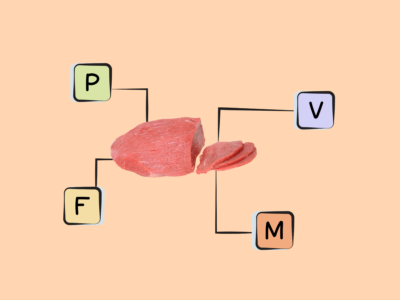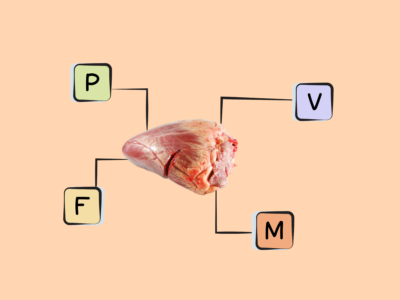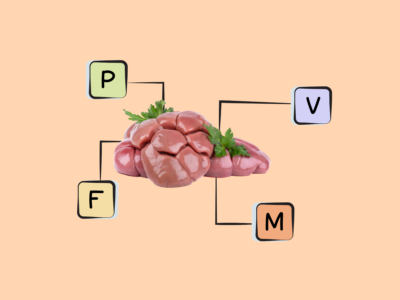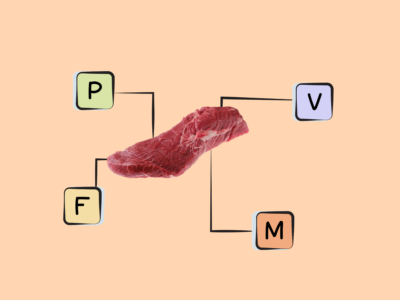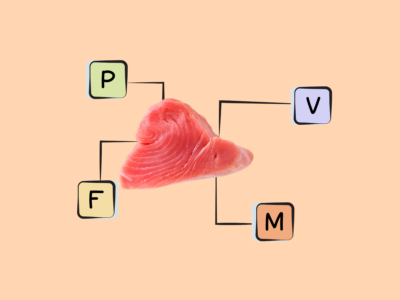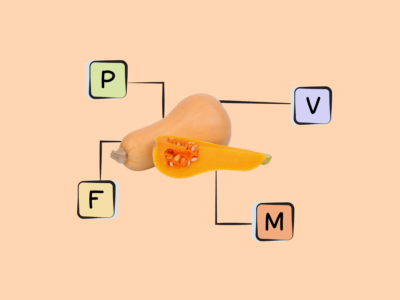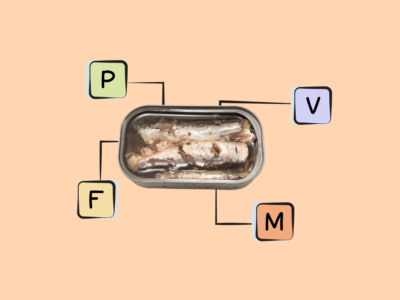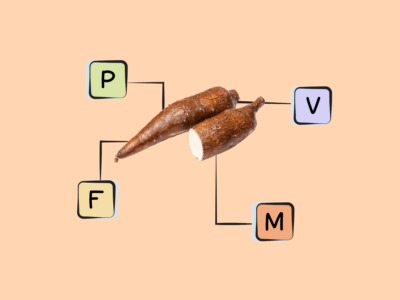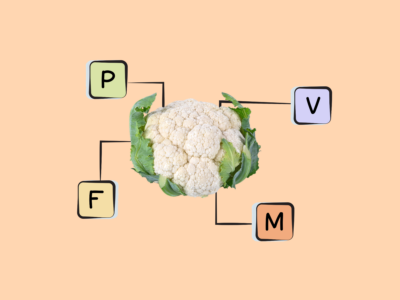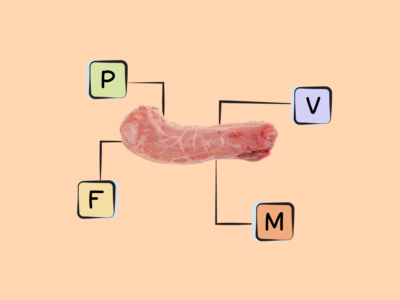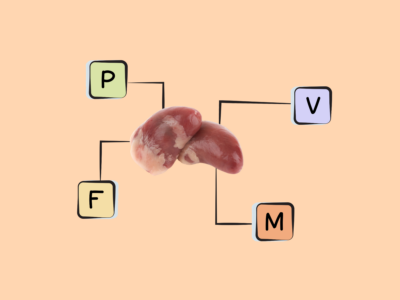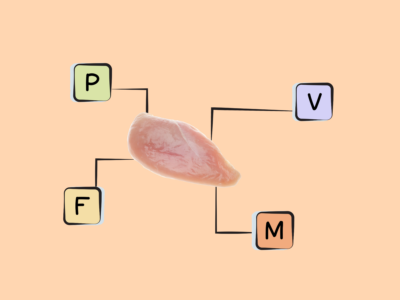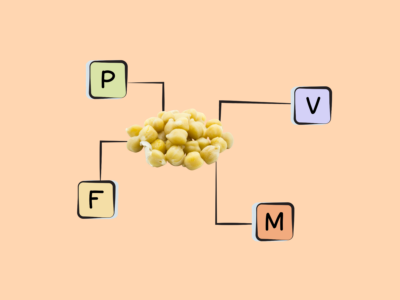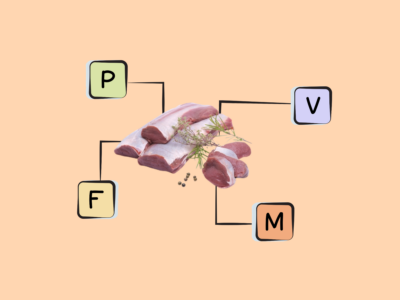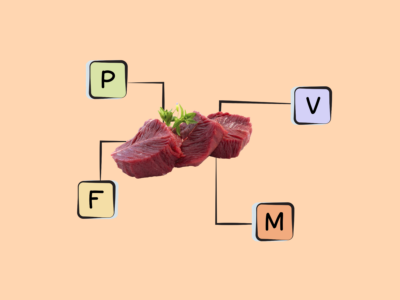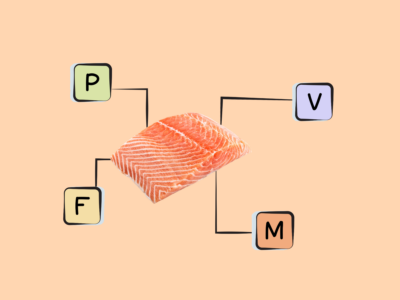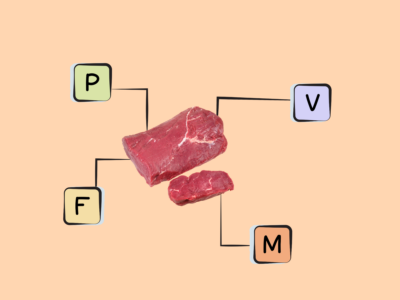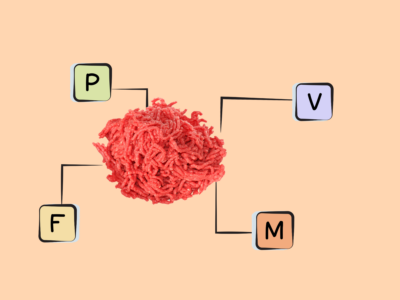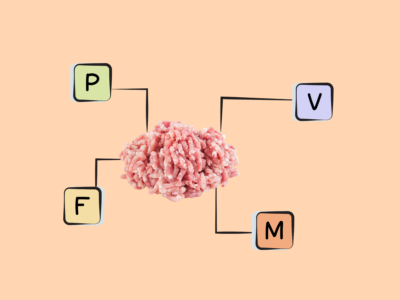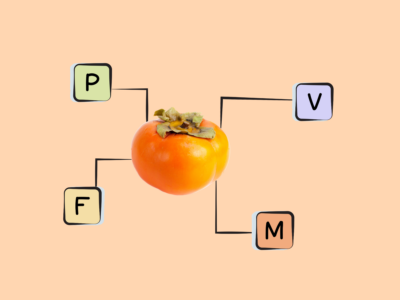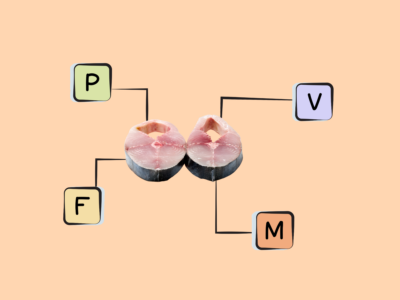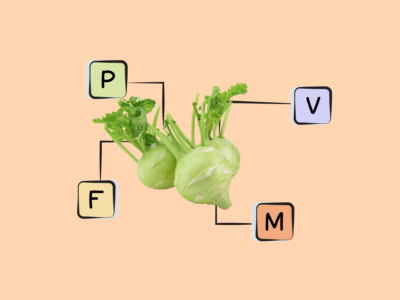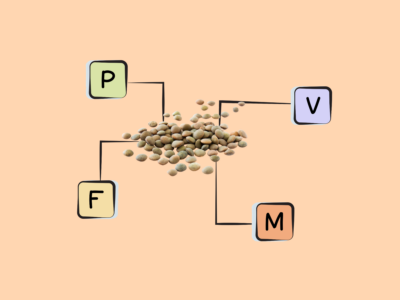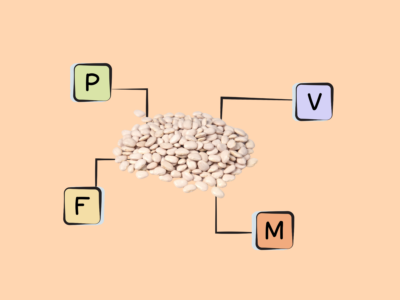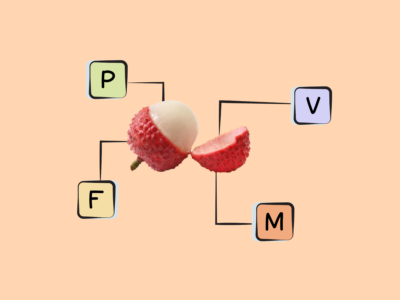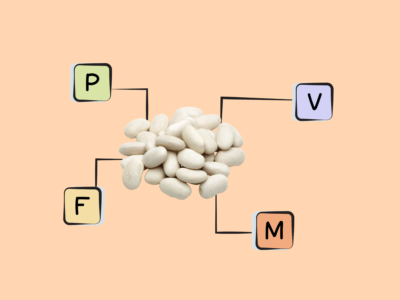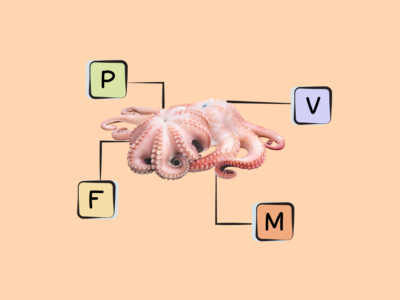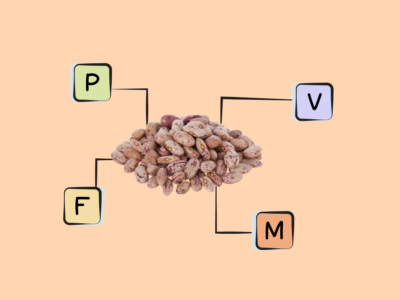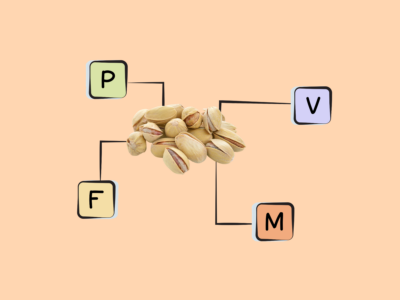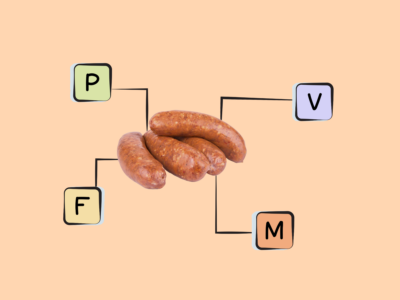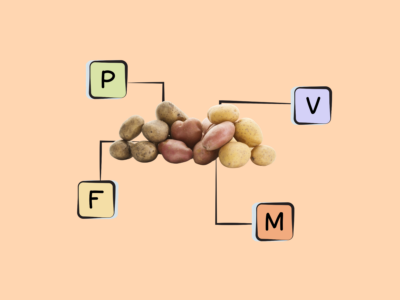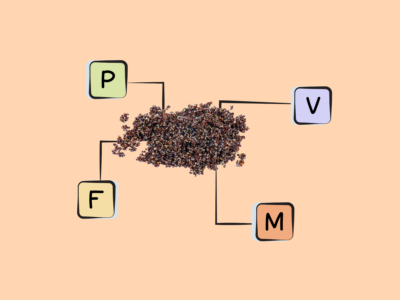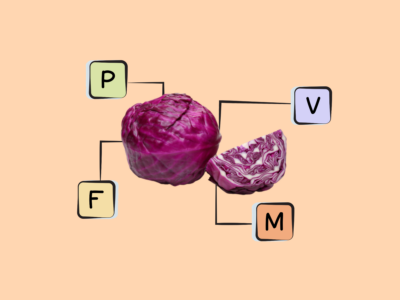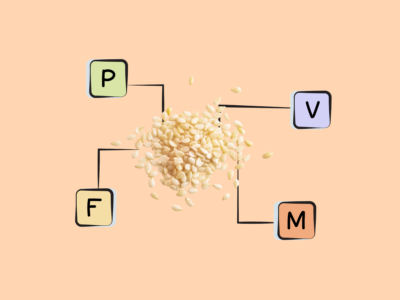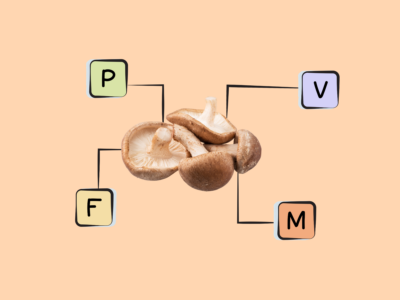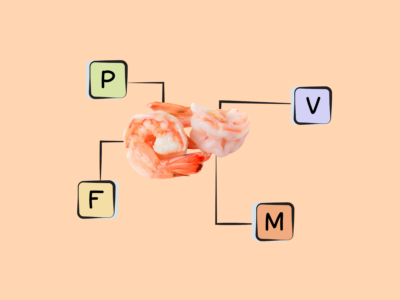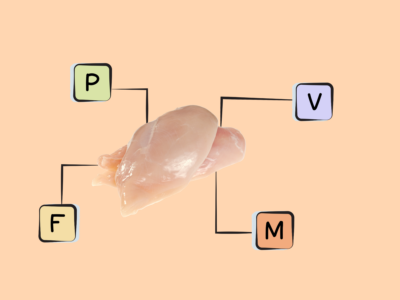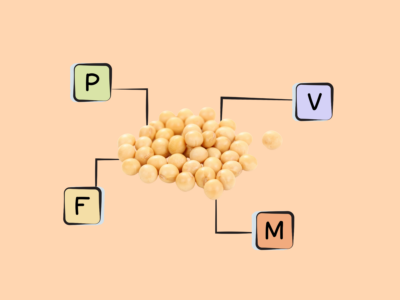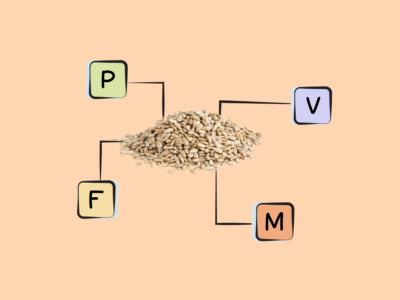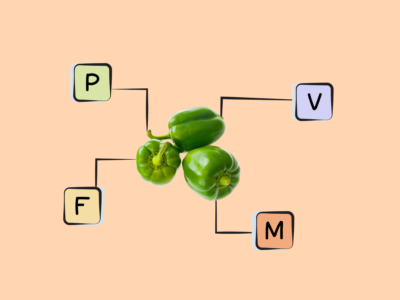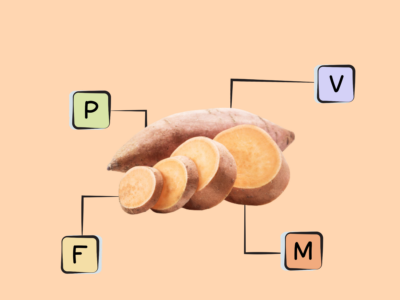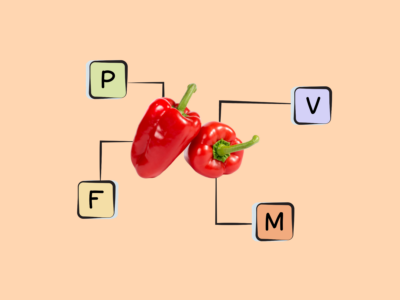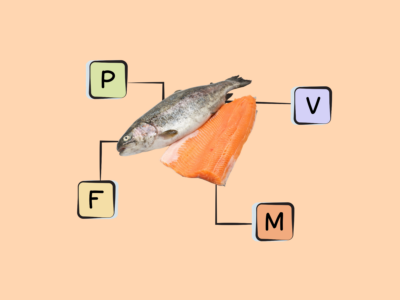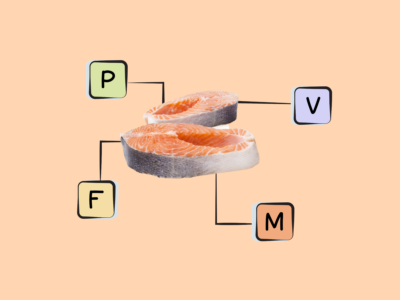Key Takeaways (expand)
- Vitamin B6, sometimes called pyridoxine, is a group of of six water-soluble compounds with a similar chemical structure, all containing a pyridine ring as their core.
- All forms of vitamin B6 can be enzymatically converted into the active form of B6, pyridoxal 5’-phospate (PLP); in this form, they express their vitamin activity.
- Vitamin B6 is needed for the function of over 100 PLP-dependent enzymes, particularly those involved in protein metabolism, hemoglobin synthesis, fatty acid metabolism, gluconeogenesis, selenium metabolism, platelet aggregation inhibition, and the release of glucose from glycogen.
- Vitamin B6 is also needed for producing the key neurotransmitters dopamine and serotonin, as well as other neurotransmitters such as glycine, GABA, glutamate, histamine, epinephrine, and norepinephrine.
- Like other B vitamins, vitamin B6 is needed for energy metabolism, with a specific role in producing NAD—a coenzyme that gets reduced to NADH to shuttle electrons in the final step of the Krebs cycle, ultimately producing ATP, the energy currency of cells.
- Higher vitamin B6 intake is linked to lower risk of heart disease, while low blood levels of vitamin B6 (in the form of PLP) is associated with increased cardiovascular disease risk; this may be due to the role of vitamin B6 in metabolizing homocysteine, and/or its impact on inflammation.
- Vitamin B6 seems to modify cancer risk as well, with prospective studies showing that higher vitamin B6 or serum PLP levels are associated with lower risk of esophageal, stomach, and colorectal cancer.
- Risk of late-life depression appears to increase for people with low vitamin B6 status, possibly due to the role of this vitamin in producing neurotransmitters; likewise, supplementing with vitamin B6 after events known to increase depression risk (such as stroke) may help reduce the occurrence of a major depressive episode.
- Some preliminary evidence suggests vitamin B6 could impact hormone function—influencing the activity of steroid receptors for hormones like testosterone, progesterone, and estrogen.
- High doses of vitamin B6 may help treat morning sickness during pregnancy, as well as reduce some symptoms of PMS.
- Severe vitamin B6 deficiency is uncommon, but is most likely to occur among alcoholics, people with impaired kidney function, people with autoimmune disorders, and those with malabsorption syndromes.
- Vitamin B6 deficiency can lead to a range of physical and neurological symptoms, including abnormal electroencephalogram (EEG) patterns, ulcers, rashes, weakened immune system, inflamed tongue, drowsiness, irritability, confusion, depression, and peripheral neuropathy; in infants, vitamin B6 deficiency can produce seizures.
- The best sources of vitamin B6 are fish, green leafy vegetables, root vegetables, many fruits, legumes, red meat, poultry, as seeds.
Table of Contents[Hide][Show]
- The Biological Roles of Vitamin B6
Vitamin B6 in Health and Disease+−
- Vitamin B6 and Cardiovascular Disease
- Vitamin B6 and Inflammation
- Vitamin B6 and Cancer
- Vitamin B6 and Late-Life Depression
- Vitamin B6 and Hormone Health
- Vitamin B6 and Kidney Stones
- Vitamin B6 and Seizures
- Vitamin B6 and Obesity
- Vitamin B6 and Fatigue
- Vitamin B6 and Migraine Headaches
- Vitamin B6 and Type 2 Diabetes
- Vitamin B6 and Restless Leg Syndrome
- Vitamin B6 and Alzheimer’s Disease
- Vitamin B6 and Blepharitis
- Health Effects of Vitamin B6 Deficiency
- Problems From Too Much Vitamin B6
- How Much Vitamin B6 Do We Need?
- Best Food Sources of Vitamin B6
- Good Food Sources of Vitamin B6
Vitamin B6 actually refers to a group of six water-soluble compounds with a similar chemical structure, all containing a pyridine ring as their core: pyridoxal (an aldehyde), pyridoxine (an alcohol), pyridoxamine (which contains an amino group), as well their phosphorylated derivatives (pyridoxal 5’-phosphate, pyridoxine 5’-phosphate, and pyridoxamine 5′-phosphate, respectively). All forms of vitamin B6 owe their vitamin activity to their ability to be enzymatically converted into the active form of B6, pyridoxal 5’-phospate. Vitamin B6 is sometimes used interchangeably with the name pyridoxine, the version of B6 commonly used in foods and supplements (though this clearly isn’t the whole vitamin B6 picture!).
Vitamin B6 was first identified in 1934 during experiments with rats, when the Hungarian physician Paul György discovered a factor that could cure the animals’ dermatitis acrodynia—a skin disease they developed in response to vitamin-free diets. He named the vitamin “B6” due to the standard practice of numbering vitamins in chronological order (the previously discovered one being B5, or pantothenic acid). In 1938, the vitamin was officially isolated and crystalized, and was soon shown to be a pyridine derivative—at which point, György proposed the name pyridoxine, a combination of “pyridine” and “oxygen.”
Like other B vitamins, it plays an important role in energy metabolism—breaking down the carbohydrates, fat, and protein we eat for use as fuel (hence why B-complex vitamins are often nicknamed the “energy vitamins!”), as well as neurotransmitter production, cellular function, and a wide variety of organ functions.
Good sources of vitamin B6 include fish, leafy greens, root vegetables, fruit such as bananas, legumes such as chickpeas, red meat, poultry, and seeds (especially sunflower and pumpkin). Some processed foods, like breakfast cereals, are also fortified with vitamin B6.
Everything You Need to Jump into Nutrivore TODAY!

Nutrivore Quickstart Guide
The Nutrivore Quickstart Guide e-book explains why and how to eat a Nutrivore diet, introduces the Nutrivore Score, gives a comprehensive tour of the full range of essential and important nutrients!
Plus, you’ll find the Top 100 Nutrivore Score Foods, analysis of food groups, practical tips to increase the nutrient density of your diet, and look-up tables for the Nutrivore Score of over 700 foods.
Buy now for instant digital access.
The Biological Roles of Vitamin B6
Vitamin B6 and its derivative, pyridoxal 5’-phosphate (PLP), are needed for over 100 different enzymes to function—most of which are involved in protein metabolism (including transaminations, racemizations, decarboxylations, and a variety of modifications to amino acid side chains). PLP is also required for a huge number of other enzymatic processes, including hemoglobin synthesis (needed for carrying oxygen through the blood), fatty acid metabolism, glucose production from amino acids (gluconeogenesis), the breakdown of methionine, the conversion of dietary selenium into its biologically active form, the biosynthesis of sphingolipids (fatty acid derivatives that participate in tissue development, toxin metabolism, and cell recognition and adhesion), expression of genes involved in glucocorticoid transcription, platelet aggregation inhibition, and the release of glucose from stored glycogen. In fact, PLP is involved in over 4% of all enzymatic reactions in the body—and given how many of these reactions are occurring every minute, that ends up being a huge number!
Overall, PLP-dependent enzymes fall into one of five structural classes known as fold types: Fold Type I is the aspartate aminotransferase family; Fold Type II is the tryptophan synthase family; Fold Type III is the alanine racemase family; Fold Type IV is the D-amino acid aminotransferase family; and Fold Type V is the glycogen phosphorylase family.
Vitamin B6 is also needed for the production of the key neurotransmitters dopamine and serotonin; this is mainly through a PLP-dependent enzyme called aromatic L-amino acid decarboxylase, which helps synthesize these neurotransmitters from tryptophan and L-3,4-dihydroxyphenylalanine (L-Dopa), respectively. Additional PLP-dependent enzymes help synthesize other neurotransmitters, too, including glycine, glutamate, GABA, histamine, epinephrine, and norepinephrine. Vitamin B6 also helps maintain the chemical balance among body fluids.
Like other B vitamins, it also plays an important role in energy metabolism—particularly the second stage of cellular respiration, called the Krebs cycle or citric acid cycle. The Krebs cycle is an incredibly important series of chemical reactions that all aerobic organisms use to generate energy, through an eight-step process taking place in a cell’s mitochondria. During this cycle, acetate (in the form of acetyl CoA) derived from carbohydrates, fat, or protein undergoes a series of redox, dehydration, hydration, and decarboxylation reactions to produce adenosine triphosphate (ATP), the energy currency for all cells—as well as the waste product carbon dioxide, and reduced forms of NADH and FADH2 (which can then be converted into yet more ATP in the last step of the Krebs cycle: oxidative phosphorylation in the electron transport chain). This is complex biochemistry, but the important part here is that there are a whole lot of chemical reactions required to produce energy for our cells, and B vitamins are essential for that process!
Vitamin B6, specifically, plays an important role in this cycle through its interactions with other nutrients. More specifically, vitamin B6 in the form of PLP is needed to convert tryptophan to niacin and producing NAD—a coenzyme that gets reduced to NADH and serves as a shuttle for electrons in the final step of the Krebs cycle, ultimately producing the all-important ATP. Reduced PLP availability has been shown to limit NAD production, whereas adequate PLP availability helps support it, keeping the Krebs cycle running!
Ready to Make Healthy Eating Feel Effortless?

Join the FREE 90-day Nutrivore90 Challenge and build lasting habits with no food rules, no guilt—just real progress.
- Weekly downloads, journal prompts, and reflection tools—all completely free.
- Focus on nutrient density, not restriction
- Nutrivore90 starts January 5th, 2026!
Vitamin B6 in Health and Disease
Vitamin B6 plays a role in the prevention and treatment of a number of diseases. Studies link higher vitamin B6 intake to a lower risk of heart disease and certain cancers, including stomach cancer, colorectal cancer, and esophageal cancer. Vitamin B6 also appears protective against late-life depression, especially after medical events like stroke. There’s some preliminary evidence that vitamin B6 can impact hormone function, namely by influencing the activity of steroid receptors for estrogen, progesterone, and testosterone. As a high-dose supplement, it’s even been used to treat morning sickness and PMS symptoms (including mood changes)!
Vitamin B6 and Cardiovascular Disease
There’s evidence for a link between vitamin B6 intake and cardiovascular disease risk.
Multiple large observational studies have found that participants with the highest intake of vitamin B6 had anywhere from a 34% to 48% lower risk of developing heart disease compared to people with the lowest intake of this nutrient. Likewise, low blood levels of vitamin B6 (in the form of PLP) tend to associate with elevated homocysteine levels and increased cardiovascular disease risk—in some studies, a near-doubling of heart disease risk among people with low blood PLP levels (under 30 nanomoles per) compared to people with higher PLP levels (at least 30 nanomoles per liter), and a 79% reduced risk of heart attack specifically among people with blood PLP levels of at least 70 nanomoles per liter.
This relationship could be due to the role of vitamin B6 in metabolizing homocysteine, an amino acid that’s been linked to cardiovascular disease development when present at high levels in the blood; two PLP-dependent enzymes are needed for converting homocysteine into the amino acid cysteine. But, while human experiments have shown that homocysteine levels rise more dramatically after a meal among people with marginal B6 deficiency compared to people with adequate B6 status, studies have failed to demonstrate that vitamin B6 intake or supplementation can lower fasting levels of homocysteine; another B vitamin, folate, is more effective for this.
Vitamin B6 and Inflammation
It’s also possible that this micronutrient influences heart disease risk via its impact on inflammation. Multiple observational studies have found that both vitamin B6 intake and blood levels of PLP are inversely associated with markers of inflammation, particularly C-reactive protein and fibrinogen—although this relationship may be more complicated than what first meets the eye, because along with vitamin B6 potentially influencing inflammation, systemic inflammation has been shown to impair vitamin B6 status, due to increasing the degradation of pyridoxal to 4-pyridoxic acid.
Vitamin B6 and Cancer
Cancer risk, too, may be modified by vitamin B6. A number of prospective studies have found that vitamin B6 and/or serum PLP levels are associated with a reduced risk of colorectal cancer, esophageal cancer, and stomach cancer; low levels of vitamin B6 are likewise associated with higher incidence. A link with breast cancer, however, has been inconsistent. A vitamin B6-cancer relationship could be due to the role of PLP in several pathways relevant to cancer, including the methionine cycle, thymidylate synthesis, and homocysteine catabolism.
Vitamin B6 and Late-Life Depression
Although studies investigating the role of vitamin B6 in cognitive decline and Alzheimer’s disease haven’t turned up any compelling evidence, vitamin B6 may help with another age-related neurological issue: late-life depression, a common disorder among the elderly—especially striking after acute illnesses like stroke or hip fracture.
Multiple observational studies have found a link between low vitamin B6 status and late-life depression, as well as total vitamin B6 intake and the incidence of depressive symptoms in the elderly. And, randomized controlled trials show that among patients who recently suffered from a stroke, supplementing with 25 mg of vitamin B6 daily (along with two other B vitamins, folic acid and vitamin B12) halved the risk of experiencing a major depressive episode over the course of the next seven years.
Given the role of PLP-dependent enzymes in producing important neurotransmitters, it’s possible that a beneficial effect of vitamin B6 on depression occurs through this route.
Vitamin B6 and Hormone Health
Limited—but intriguing—evidence suggest that vitamin B6 (in the form of PLP) can impact hormone function, influencing the activity of steroid receptors and decreasing their effects on gene expression. Specifically, PLP can interact with a repressor of nuclear receptors called RIP140/NRIP1, which has some important roles in reproductive biology. Although speculative so far, it’s possible that PLP can inhibit the activity of steroid receptors for hormones like progesterone, estrogen, and testosterone, making vitamin B6 potentially relevant in the development of hormone-related disease like breast cancer and prostate cancer. But, much more research is needed before we can say anything for certain!
High doses of vitamin B6 have a therapeutic benefit for several conditions. Since the 1940s, vitamin B6 has been used to treat morning sickness in pregnant individuals, and controlled trials have confirmed that it’s effective at reducing nausea during early pregnancy.
Studies also indicate that supplemental vitamin B6 (at doses of up to 100 mg per day) may help reduce some symptoms of PMS, including those related to mood.
Vitamin B6 and Kidney Stones
Similarly, vitamin B6 has a potential (but insufficiently researched) effect on kidney stone prevention. A large prospective study found that compared to women with the lowest intakes of vitamin B6, women consuming 40 mg or more each day had their risk of kidney stones cut by a third. Some controlled experiments, too, support a causative relationship here, with data showing that supplementing with pyridoxamine can reduce urinary oxalate levels and the subsequent formation of calcium oxalate kidney stones. But, the evidence so far is still too limited for vitamin B6 to be officially prescribed for kidney stones!
Vitamin B6 and Seizures
A small prospective study from 2022 found that among adults with epilepsy, low blood levels of vitamin B6 were associated with poor seizure control. Multiple studies have also found a high prevalence of vitamin B6 deficiency among patients with status epilepticus—a seizure that lasts more than five minutes, or multiple seizures without a return to normal consciousness between them.
Vitamin B6 insufficiency has also been shown to directly cause seizures that resolve with vitamin B6 supplementation. Along with inadequate intake of vitamin B6, certain medications and some conditions such as liver disease, pregnancy, and alcoholism can lead to vitamin B6-related seizures due to increased vitamin B6 demands or depletion. In infants, pyridoxine-dependent seizures (PDS) can occur due to mutations in the ALDH7A1 gene.
Vitamin B6 and Obesity
A number of studies have found that vitamin B6 levels are negatively associated with obesity, body fat percentage, visceral fat area, and/or waist circumference. Likewise, vitamin B6 intake has shown promise for supporting healthy body composition in controlled trials! A 2021 randomized controlled trial found that in overweight and obese women, eight weeks of high-dose vitamin B6 supplementation (80 mg pyridoxine hydrochloride daily) led to decreases in total body weight, fat mass, waist circumference, fasting insulin, HOMA-IR, total cholesterol, LDL, triglycerides, and leptin, as well as increases in adiponectin.
Similarly, in a 2008 randomized controlled trial of overweight or obese women, rises in PLP levels (as a result of high-vitamin-B6 in intervention diets) corresponded with better preservation of fat-free mass during weight loss.
Vitamin B6 and Fatigue
Some evidence suggests that vitamin B6 in conjunction with other B vitamins may help reduce fatigue and boost exercise performance. Likewise, chronic fatigue patients have been shown to have reduced levels of vitamin B6. However, more research on vitamin B6 alone in relation to fatigue is needed!
Vitamin B6 and Migraine Headaches
Vitamin B6 may be a boon for migraine sufferers! A 2020 review found that vitamin B6, alone or in combination with other B vitamins, was effective for helping prevent migraines with aura in adults. Likewise, a 2015 double-blind randomized clinical trial found that vitamin B6 supplementation (80 mg daily) successfully reduced headache severity and attack duration for migraine sufferers.
Vitamin B6 and Type 2 Diabetes
Vitamin B6 may play a protective role in type 2 diabetes, as well as several of its complications. Observational and experimental studies show that vitamin B6 levels are inversely associated with type 2 diabetes, and studies in both animal models and humans report that vitamin B6 supplementation can lower blood glucose levels, glycosylated hemoglobin levels, and postprandial blood sugar levels (the latter due to inhibiting the activity of small-intestinal alpha-glucosidases). Likewise, vitamin B6 insufficiency has been shown to impair insulin secretion.
Vitamin B6 may also help protect against some complications of diabetes caused by persistent high blood glucose levels: diabetic retinopathy (diabetes-induced damage to the retina) and diabetic neuropathy (diabetes-induced nerve damage). In observational studies, low levels of vitamin B6 are associated with higher risk of both of these conditions. Conversely, a 2020 study of nearly 1000 diabetic patients found that high vitamin B6 intake was associated with a lower incidence of diabetic retinopathy.
What’s more, trials of vitamin B6 supplementation have shown this nutrient can significantly reduce diabetic neuropathy, as well as prevent its progression.
Vitamin B6 and Restless Leg Syndrome
A 2022 randomized controlled trial found that among patients with restless leg syndrome, two months of supplementing with 40 mg vitamin B6 daily led to significant improvements in disease severity and the quality of sleep, relative to the control group. Additional studies are needed!
Vitamin B6 and Alzheimer’s Disease
Some research suggests a link between vitamin B6 and Alzheimer’s disease incidence, certain features of Alzheimer’s disease, cognitive decline, and dementia. For example, a 2005 study found that low vitamin B6 levels were associated with white matter lesions in Alzheimer’s disease. And, a 2013 randomized controlled trial of patients with high dementia risk found that high-dose B-vitamin supplementation (20 mg of vitamin B6 daily, along with 0.8 mg of folic acid and 0.5 mg of vitamin B12) slowed brain volume shrinkage and reduced cerebral atrophy in certain gray matter regions implicated in Alzheimer’s disease and cognitive decline! However, the research here hasn’t been fully consistent, and more large well-designed studies are needed to establish cause and effect!
Vitamin B6 and Blepharitis
Insufficient levels of vitamin B6 have been shown to contribute to blepharitis, a condition involving inflammation of the eyelid. However, more research is needed on this topic!
Didn’t know vitamin B6 was this amazing? Maybe your friends will enjoy this too!
Health Effects of Vitamin B6 Deficiency
Severe vitamin B6 deficiency is uncommon, but tends to be more likely in alcoholics (due to both impaired metabolism and low dietary intakes), as well as people with impaired kidney function, autoimmune disorders (such as rheumatoid arthritis), malabsorption syndromes (like celiac disease, ulcerative colitis, and Crohn’s disease). When it does occur, B6 deficiency can lead to abnormal electroencephalogram (EEG) patterns, ulcers on the mouth and skin, rashes, weakened immune system, and inflammation of the tongue, as well as neurological symptoms like drowsiness, irritability, confusion, depression, and peripheral neuropathy (numbness or pain in the hands and feet, resulting from nerve damage). In infants, vitamin B6 deficiency can cause seizures (sadly, this was discovered in the 1950s when a manufacturing error in infant formulas led to babies becoming severely B6 deficient). Due to its role in hemoglobin synthesis, vitamin B6 deficiency can also lead to microcytic anemia—a form of anemia characterized by smaller-than-normal red blood cells.
Even with adequate intake, other factors can raise vitamin B6 needs and increase the risk of insufficiency. Both in vitro experiments and clinical trials have shown that systemic inflammation, involved in most chronic diseases, can impair the metabolism of vitamin B6. Some medications also interfere with B6 metabolism, including estrogen-containing oral contraceptives and methylxanthines (commonly used for treating respiratory conditions like asthma and COPD); anti-tuberculosis medications, Parkinson’s disease drugs like L-Dopa, and penicillamine (a metal chelator) are known to form complexes with vitamin B6 and make it less bioavailable, in turn raising the risk of deficiency. Long-term use of nonsteroidal anti-inflammatory drugs can also interfere with the metabolism of vitamin B6.
Although vegans and vegetarians don’t appear to be at significantly higher risk of vitamin B6 deficiency than meat eaters, it’s worth noting that plant foods tend to contain a unique form of B6 called pyridoxine glucoside, which is only about half as bioavailable as vitamin B6 from other foods and supplements.
Problems From Too Much Vitamin B6
Although it’s nearly impossible to eat enough vitamin B6 from food sources to experience toxicity (due to it being a water-soluble vitamin, meaning excess is excreted rather than stored), long-term, high-dose supplementation of pyridoxine (in excess of 1000 mg per day) can adversely affect the nervous system. In particular, sensory neuropathy can occur, which includes symptoms like pain, loss of coordination, burning sensations, numbness in the extremities, and difficulty walking. Skin lesions and gastrointestinal symptoms can also result from excessive vitamin B6. Luckily, no evidence of nerve damage exists from intakes below 200 mg of pyridoxine daily.
Want to know the top 25 foods for this awesome nutrient?

The Top 25 Foods for Every Nutrient
The Top 25 Foods for Every Nutrient e-book is a well-organized, easy-to-use, grocery store-friendly guide to help you choose foods that fit your needs of 43 important nutrients while creating a balanced nutrient-dense diet.
Get two “Top 25” food lists for each nutrient, plus you’ll find RDA charts for everyone, informative visuals, fun facts, serving sizes and the 58 foods that are Nutrient Super Stars!
Buy now for instant digital access.
How Much Vitamin B6 Do We Need?
The recommended dietary allowance (RDA) for vitamin B6 is 1.3 mg for adults aged 19 to 50 (1.9 mg for day for pregnant women, and 2 mg per day during breastfeeding/lactation); for adults over 50, the RDA increases to 1.5 mg daily for women and 1.7 mg daily for men. However, the protective effects of vitamin B6 on conditions like heart disease, depression, kidney stones, and cancer are generally seen at higher intakes than these levels!
| 0 – 6 months | |||||
| 6 months to < 12 months | |||||
| 1 yr – 3 yrs | |||||
| 4 yrs – 8 yrs | |||||
| 9 yrs – 13 yrs | |||||
| 14 yrs – 18 yrs | |||||
| 19 yrs – 50 yrs | |||||
| 51+ yrs | |||||
| Pregnant (14 – 18 yrs) | |||||
| Pregnant (19 – 30 yrs) | |||||
| Pregnant (31 – 50 yrs) | |||||
| Lactating (14 – 18 yrs) | |||||
| Lactating (19 – 30 yrs) | |||||
| Lactating (31 – 50 yrs) |
Nutrient Daily Values
Nutrition requirements and recommended nutrient intake for infants, children, adolescents, adults, mature adults, and pregnant and lactating individuals.
Best Food Sources of Vitamin B6
The following foods have high concentrations of vitamin B6, containing at least 50% of the recommended dietary allowance per serving, making them our best food sources of this valuable B-vitamin!
Want to know the top 500 most nutrient-dense foods?

Top 500 Nutrivore Foods
The Top 500 Nutrivore Foods e-book is an amazing reference deck of the top 500 most nutrient-dense foods according to their Nutrivore Score. Think of it as the go-to resource for a super-nerd, to learn more and better understand which foods stand out, and why!
If you are looking for a quick-reference guide to help enhance your diet with nutrients, and dive into the details of your favorite foods, this book is your one-stop-shop!
Buy now for instant digital access.
Good Food Sources of Vitamin B6
The following foods are also excellent or good sources of vitamin B6, containing at least 10% (and up to 50%) of the daily value per serving.
Ditch Diets. Embrace Nutrients. Start with this FREE Guide.
Sign up for the free Nutrivore Newsletter, your weekly, science-backed guide to improving health through nutrient-rich foods — without dieting harder —and get the Beginner’s Guide to Nutrivore delivered straight to your inbox!

Citations
Expand to see all scientific references for this article.
Bender DA. Non-nutritional uses of vitamin B6. Br J Nutr. 1999 Jan;81(1):7-20.
Bosy-Westphal A, Holzapfel A, Czech N, Müller MJ. Plasma folate but not vitamin B(12) or homocysteine concentrations are reduced after short-term vitamin B(6) supplementation. Ann Nutr Metab. 2001;45(6):255-8. doi: 10.1159/000046735.
Chetyrkin SV, Kim D, Belmont JM, Scheinman JI, Hudson BG, Voziyan PA. Pyridoxamine lowers kidney crystals in experimental hyperoxaluria: a potential therapy for primary hyperoxaluria. Kidney Int. 2005 Jan;67(1):53-60. doi: 10.1111/j.1523-1755.2005.00054.x.
Chiang EP, Bagley PJ, Selhub J, Nadeau M, Roubenoff R. Abnormal vitamin B(6) status is associated with severity of symptoms in patients with rheumatoid arthritis. Am J Med. 2003 Mar;114(4):283-7. doi: 10.1016/s0002-9343(02)01528-0.
Clarke R, Halsey J, Bennett D, Lewington S. Homocysteine and vascular disease: review of published results of the homocysteine-lowering trials. J Inherit Metab Dis. 2011 Feb;34(1):83-91. doi: 10.1007/s10545-010-9235-y.
Curhan GC, Willett WC, Speizer FE, Stampfer MJ. Intake of vitamins B6 and C and the risk of kidney stones in women. J Am Soc Nephrol. 1999 Apr;10(4):840-5. doi: 10.1681/ASN.V104840.
Dave HN, Eugene Ramsay R, Khan F, Sabharwal V, Irland M. Pyridoxine deficiency in adult patients with status epilepticus. Epilepsy Behav. 2015 Nov;52(Pt A):154-8. doi: 10.1016/j.yebeh.2015.08.015.
Douaud G, Refsum H, de Jager CA, Jacoby R, Nichols TE, Smith SM, Smith AD. Preventing Alzheimer’s disease-related gray matter atrophy by B-vitamin treatment. Proc Natl Acad Sci U S A. 2013 Jun 4;110(23):9523-8. doi: 10.1073/pnas.1301816110.
Friso S, Girelli D, Martinelli N, Olivieri O, Lotto V, Bozzini C, Pizzolo F, Faccini G, Beltrame F, Corrocher R. Low plasma vitamin B-6 concentrations and modulation of coronary artery disease risk. Am J Clin Nutr. 2004 Jun;79(6):992-8. doi: 10.1093/ajcn/79.6.992.
Fu Y, Zhu Z, Huang Z, He R, Zhang Y, Li Y, Tan W, Rong S. Association between Vitamin B and Obesity in Middle-Aged and Older Chinese Adults. Nutrients. 2023 Jan 17;15(3):483. doi: 10.3390/nu15030483.
Galluzzi L, Vacchelli E, Michels J, Garcia P, Kepp O, Senovilla L, Vitale I, Kroemer G. Effects of vitamin B6 metabolism on oncogenesis, tumor progression and therapeutic responses. Oncogene. 2013 Oct 17;32(42):4995-5004. doi: 10.1038/onc.2012.623. Epub 2013
Haidari F, Mohammadshahi M, Zarei M, Haghighizadeh MH, Mirzaee F. The Effect of Pyridoxine Hydrochloride Supplementation on Leptin, Adiponectin, Glycemic Indices, and Anthropometric Indices in Obese and Overweight Women. Clin Nutr Res. 2021 Jul 22;10(3):230-242. doi: 10.7762/cnr.2021.10.3.230.
Heap LC, Peters TJ, Wessely S. Vitamin B status in patients with chronic fatigue syndrome. J R Soc Med. 1999 Apr;92(4):183-5. doi: 10.1177/014107689909200405.
Horikawa C, Aida R, Kamada C, Fujihara K, Tanaka S, Tanaka S, Araki A, Yoshimura Y, Moriya T, Akanuma Y, Sone H; Japan Diabetes Complications Study Group. Vitamin B6 intake and incidence of diabetic retinopathy in Japanese patients with type 2 diabetes: analysis of data from the Japan Diabetes Complications Study (JDCS). Eur J Nutr. 2020 Jun;59(4):1585-1594. doi: 10.1007/s00394-019-02014-4.
Huang T, Chen Y, Yang B, Yang J, Wahlqvist ML, Li D. Meta-analysis of B vitamin supplementation on plasma homocysteine, cardiovascular and all-cause mortality. Clin Nutr. 2012 Aug;31(4):448-54. doi: 10.1016/j.clnu.2011.01.003.
Huq MD, Tsai NP, Lin YP, Higgins L, Wei LN. Vitamin B6 conjugation to nuclear corepressor RIP140 and its role in gene regulation. Nat Chem Biol. 2007 Mar;3(3):161-5. doi: 10.1038/nchembio861.
Hunt IF, Murphy NJ, Martner-Hewes PM, Faraji B, Swendseid ME, Reynolds RD, Sanchez A, Mejia A. Zinc, vitamin B-6, and other nutrients in pregnant women attending prenatal clinics in Mexico. Am J Clin Nutr. 1987 Oct;46(4):563-9. doi: 10.1093/ajcn/46.4.563.
Institute of Medicine (US) Standing Committee on the Scientific Evaluation of Dietary Reference Intakes and its Panel on Folate, Other B Vitamins, and Choline. Dietary Reference Intakes for Thiamin, Riboflavin, Niacin, Vitamin B6, Folate, Vitamin B12, Pantothenic Acid, Biotin, and Choline. Washington (DC): National Academies Press (US); 1998.
Ishihara J, Iso H, Inoue M, Iwasaki M, Okada K, Kita Y, Kokubo Y, Okayama A, Tsugane S; JPHC Study Group. Intake of folate, vitamin B6 and vitamin B12 and the risk of CHD: the Japan Public Health Center-Based Prospective Study Cohort I. J Am Coll Nutr. 2008 Feb;27(1):127-36. doi: 10.1080/07315724.2008.10719684.
Jadidi A, Rezaei Ashtiani A, Khanmohamadi Hezaveh A, Aghaepour SM. Therapeutic effects of magnesium and vitamin B6 in alleviating the symptoms of restless legs syndrome: a randomized controlled clinical trial. BMC Complement Med Ther. 2022 Dec 31;23(1):1. doi: 10.1186/s12906-022-03814-8.
Koren G, Clark S, Hankins GD, Caritis SN, Miodovnik M, Umans JG, Mattison DR. Effectiveness of delayed-release doxylamine and pyridoxine for nausea and vomiting of pregnancy: a randomized placebo controlled trial. Am J Obstet Gynecol. 2010 Dec;203(6):571.e1-7. doi: 10.1016/j.ajog.2010.07.030.
Larsson SC, Orsini N, Wolk A. Vitamin B6 and risk of colorectal cancer: a meta-analysis of prospective studies. JAMA. 2010 Mar 17;303(11):1077-83. doi: 10.1001/jama.2010.263.
Lee BJ, Huang MC, Chung LJ, Cheng CH, Lin KL, Su KH, Huang YC. Folic acid and vitamin B12 are more effective than vitamin B6 in lowering fasting plasma homocysteine concentration in patients with coronary artery disease. Eur J Clin Nutr. 2004 Mar;58(3):481-7. doi: 10.1038/sj.ejcn.1601834.
Lee DG, Lee Y, Shin H, Kang K, Park JM, Kim BK, Kwon O, Lee JJ. Seizures Related to Vitamin B6 Deficiency in Adults. J Epilepsy Res. 2015 Jun 30;5(1):23-4. doi: 10.14581/jer.15006.
Lee MC, Hsu YJ, Shen SY, Ho CS, Huang CC. A functional evaluation of anti-fatigue and exercise performance improvement following vitamin B complex supplementation in healthy humans, a randomized double-blind trial. Int J Med Sci. 2023 Aug 15;20(10):1272-1281. doi: 10.7150/ijms.86738.
Liampas IN, Siokas V, Aloizou AM, Tsouris Z, Dastamani M, Aslanidou P, Brotis A, Dardiotis E. Pyridoxine, folate and cobalamin for migraine: A systematic review. Acta Neurol Scand. 2020 Aug;142(2):108-120. doi: 10.1111/ane.13251.
Lin PT, Cheng CH, Liaw YP, Lee BJ, Lee TW, Huang YC. Low pyridoxal 5′-phosphate is associated with increased risk of coronary artery disease. Nutrition. 2006 Nov-Dec;22(11-12):1146-51. doi: 10.1016/j.nut.2006.08.013.
Lussana F, Zighetti ML, Bucciarelli P, Cugno M, Cattaneo M. Blood levels of homocysteine, folate, vitamin B6 and B12 in women using oral contraceptives compared to non-users. Thromb Res. 2003;112(1-2):37-41. doi: 10.1016/j.thromres.2003.11.007.
Magee LA, Mazzotta P, Koren G. Evidence-based view of safety and effectiveness of pharmacologic therapy for nausea and vomiting of pregnancy (NVP). Am J Obstet Gynecol. 2002 May;186(5 Suppl Understanding):S256-61. doi: 10.1067/mob.2002.122596.
Maltepe C, Koren G. The management of nausea and vomiting of pregnancy and hyperemesis gravidarum–a 2013 update. J Popul Ther Clin Pharmacol. 2013;20(2):e184-92.
Mascolo E, Vernì F. Vitamin B6 and Diabetes: Relationship and Molecular Mechanisms. Int J Mol Sci. 2020 May 23;21(10):3669. doi: 10.3390/ijms21103669.
Merete C, Falcon LM, Tucker KL. Vitamin B6 is associated with depressive symptomatology in Massachusetts elders. J Am Coll Nutr. 2008 Jun;27(3):421-7. doi: 10.1080/07315724.2008.10719720.
Meydani SN, Ribaya-Mercado JD, Russell RM, Sahyoun N, Morrow FD, Gershoff SN. Vitamin B-6 deficiency impairs interleukin 2 production and lymphocyte proliferation in elderly adults. Am J Clin Nutr. 1991 May;53(5):1275-80. doi: 10.1093/ajcn/53.5.1275.
Morris MC, Schneider JA, Tangney CC. Thoughts on B-vitamins and dementia. J Alzheimers Dis. 2006 Aug;9(4):429-33. doi: 10.3233/jad-2006-9409.
Morris MS, Sakakeeny L, Jacques PF, Picciano MF, Selhub J. Vitamin B-6 intake is inversely related to, and the requirement is affected by, inflammation status. J Nutr. 2010 Jan;140(1):103-10. doi: 10.3945/jn.109.114397.
Mulder C, Scheltens P, Barkhof F, Gundy C, Verstraeten RA, de Leeuw FE. Low vitamin B6 levels are associated with white matter lesions in Alzheimer’s disease. J Am Geriatr Soc. 2005 Jun;53(6):1073-4. doi: 10.1111/j.1532-5415.2005.53338_1.x.
Nakamura S, Li H, Adijiang A, Pischetsrieder M, Niwa T. Pyridoxal phosphate prevents progression of diabetic nephropathy. Nephrol Dial Transplant. 2007 Aug;22(8):2165-74. doi: 10.1093/ndt/gfm166.
Oxenkrug G. Insulin resistance and dysregulation of tryptophan-kynurenine and kynurenine-nicotinamide adenine dinucleotide metabolic pathways. Mol Neurobiol. 2013 Oct;48(2):294-301. doi: 10.1007/s12035-013-8497-4.
Page JH, Ma J, Chiuve SE, Stampfer MJ, Selhub J, Manson JE, Rimm EB. Plasma vitamin B(6) and risk of myocardial infarction in women. Circulation. 2009 Aug 25;120(8):649-55. doi: 10.1161/CIRCULATIONAHA.108.809038.
Pan WH, Chang YP, Yeh WT, Guei YS, Lin BF, Wei IL, Yang FL, Liaw YP, Chen KJ, Chen WJ. Co-occurrence of anemia, marginal vitamin B6, and folate status and depressive symptoms in older adults. J Geriatr Psychiatry Neurol. 2012 Sep;25(3):170-8. doi: 10.1177/0891988712458365.
Paul L, Ueland PM, Selhub J. Mechanistic perspective on the relationship between pyridoxal 5′-phosphate and inflammation. Nutr Rev. 2013 Apr;71(4):239-44. doi: 10.1111/nure.12014.
Przybelski AG, Bendlin BB, Jones JE, Vogt NM, Przybelski RJ. Vitamin B6 and vitamin D deficiency co-occurrence in geriatric memory patients. Alzheimers Dement (Amst). 2024 Jan 22;16(1):e12525. doi: 10.1002/dad2.12525.
Qin X, Huo Y, Xie D, Hou F, Xu X, Wang X. Homocysteine-lowering therapy with folic acid is effective in cardiovascular disease prevention in patients with kidney disease: a meta-analysis of randomized controlled trials. Clin Nutr. 2013 Oct;32(5):722-7. doi: 10.1016/j.clnu.2012.12.009.
Rane S, Elrahi S, Villarreal J, Zulfi H, Fang X, Graf D, Rodriguez R, Garza A, Thottempudi N, Rai P, Masel T. Low Serum Pyridoxine Levels Worsen Seizure Control in Adult Epilepsy Patients. Cureus. 2022 Jun 5;14(6):e25669. doi: 10.7759/cureus.25669.
Rimm EB, Willett WC, Hu FB, Sampson L, Colditz GA, Manson JE, Hennekens C, Stampfer MJ. Folate and vitamin B6 from diet and supplements in relation to risk of coronary heart disease among women. JAMA. 1998 Feb 4;279(5):359-64. doi: 10.1001/jama.279.5.359.
Rios-Avila L, Nijhout HF, Reed MC, Sitren HS, Gregory JF 3rd. A mathematical model of tryptophan metabolism via the kynurenine pathway provides insights into the effects of vitamin B-6 deficiency, tryptophan loading, and induction of tryptophan 2,3-dioxygenase on tryptophan metabolites. J Nutr. 2013 Sep;143(9):1509-19. doi: 10.3945/jn.113.174599.
Robinson K, Mayer EL, Miller DP, Green R, van Lente F, Gupta A, Kottke-Marchant K, Savon SR, Selhub J, Nissen SE, et al. Hyperhomocysteinemia and low pyridoxal phosphate. Common and independent reversible risk factors for coronary artery disease. Circulation. 1995 Nov 15;92(10):2825-30. doi: 10.1161/01.cir.92.10.2825.
Rodríguez-Rodríguez E, López-Sobaler AM, Navarro AR, Bermejo LM, Ortega RM, Andrés P. Vitamin B6 status improves in overweight/obese women following a hypocaloric diet rich in breakfast cereals, and may help in maintaining fat-free mass. Int J Obes (Lond). 2008 Oct;32(10):1552-8. doi: 10.1038/ijo.2008.131.
Rubinos C, Bruzzone MJ, Blodgett C, Tsai C, Patel P, Hianik R, Jadav R, Boudesseul J, Liu C, Zhu H, Wilson SE, Olm-Shipman C, Meeker R, Hirsch LJ. Association of Serum Pyridoxal Phosphate Levels with Established Status Epilepticus. Neurocrit Care. 2023 Feb;38(1):41-51. doi: 10.1007/s12028-022-01579-z.
Sadeghi O, Nasiri M, Maghsoudi Z, Pahlavani N, Rezaie M, Askari G. Effects of pyridoxine supplementation on severity, frequency and duration of migraine attacks in migraine patients with aura: A double-blind randomized clinical trial study in Iran. Iran J Neurol. 2015 Apr 4;14(2):74-80.
Sahakian V, Rouse D, Sipes S, Rose N, Niebyl J. Vitamin B6 is effective therapy for nausea and vomiting of pregnancy: a randomized, double-blind placebo-controlled study. Obstet Gynecol. 1991 Jul;78(1):33-6.
Sakakeeny L, Roubenoff R, Obin M, Fontes JD, Benjamin EJ, Bujanover Y, Jacques PF, Selhub J. Plasma pyridoxal-5-phosphate is inversely associated with systemic markers of inflammation in a population of U.S. adults. J Nutr. 2012 Jul;142(7):1280-5. doi: 10.3945/jn.111.153056.
Schnackerz KD, Benesch RE, Kwong S, Benesch R, Helmreich EJ. Specific receptor sites for pyridoxal 5′-phosphate and pyridoxal 5′-deoxymethylenephosphonate at the alpha and beta NH2-terminal regions of hemoglobin. J Biol Chem. 1983 Jan 25;258(2):872-5.
Shen J, Lai CQ, Mattei J, Ordovas JM, Tucker KL. Association of vitamin B-6 status with inflammation, oxidative stress, and chronic inflammatory conditions: the Boston Puerto Rican Health Study. Am J Clin Nutr. 2010 Feb;91(2):337-42. doi: 10.3945/ajcn.2009.28571.
Skarupski KA, Tangney C, Li H, Ouyang B, Evans DA, Morris MC. Longitudinal association of vitamin B-6, folate, and vitamin B-12 with depressive symptoms among older adults over time. Am J Clin Nutr. 2010 Aug;92(2):330-5. doi: 10.3945/ajcn.2010.29413.
Song Y, Manson JE, Lee IM, Cook NR, Paul L, Selhub J, Giovannucci E, Zhang SM. Effect of combined folic acid, vitamin B(6), and vitamin B(12) on colorectal adenoma. J Natl Cancer Inst. 2012 Oct 17;104(20):1562-75. doi: 10.1093/jnci/djs370.
Talbott MC, Miller LT, Kerkvliet NI. Pyridoxine supplementation: effect on lymphocyte responses in elderly persons. Am J Clin Nutr. 1987 Oct;46(4):659-64. doi: 10.1093/ajcn/46.4.659.
Taylor EN, Stampfer MJ, Curhan GC. Dietary factors and the risk of incident kidney stones in men: new insights after 14 years of follow-up. J Am Soc Nephrol. 2004 Dec;15(12):3225-32. doi: 10.1097/01.ASN.0000146012.44570.20.
Tong Y. Seizures caused by pyridoxine (vitamin B6) deficiency in adults: A case report and literature review. Intractable Rare Dis Res. 2014 May;3(2):52-6. doi: 10.5582/irdr.2014.01005.
Ulvik A, Midttun Ø, Pedersen ER, Eussen SJ, Nygård O, Ueland PM. Evidence for increased catabolism of vitamin B-6 during systemic inflammation. Am J Clin Nutr. 2014 Jul;100(1):250-5. doi: 10.3945/ajcn.114.083196.
Villegas-Salas E, Ponce de León R, Juárez-Perez MA, Grubb GS. Effect of vitamin B6 on the side effects of a low-dose combined oral contraceptive. Contraception. 1997 Apr;55(4):245-8. doi: 10.1016/s0010-7824(97)00005-x.
Vitamin B6: Fact Sheet for Health Professionals. National Institutes of Health (NIH) Office of Dietary Supplements. 2 Jun 2022.
Vutyavanich T, Wongtra-ngan S, Ruangsri R. Pyridoxine for nausea and vomiting of pregnancy: a randomized, double-blind, placebo-controlled trial. Am J Obstet Gynecol. 1995 Sep;173(3 Pt 1):881-4. doi: 10.1016/0002-9378(95)90359-3.
Wilson SM, Bivins BN, Russell KA, Bailey LB. Oral contraceptive use: impact on folate, vitamin B₆, and vitamin B₁₂ status. Nutr Rev. 2011 Oct;69(10):572-83. doi: 10.1111/j.1753-4887.2011.00419.x.
Wu W, Kang S, Zhang D. Association of vitamin B6, vitamin B12 and methionine with risk of breast cancer: a dose-response meta-analysis. Br J Cancer. 2013 Oct 1;109(7):1926-44. doi: 10.1038/bjc.2013.438.
Wyatt KM, Dimmock PW, Jones PW, Shaughn O’Brien PM. Efficacy of vitamin B-6 in the treatment of premenstrual syndrome: systematic review. BMJ. 1999 May 22;318(7195):1375-81. doi: 10.1136/bmj.318.7195.1375.
Xiao Q, Freedman ND, Ren J, Hollenbeck AR, Abnet CC, Park Y. Intakes of folate, methionine, vitamin B6, and vitamin B12 with risk of esophageal and gastric cancer in a large cohort study. Br J Cancer. 2014 Mar 4;110(5):1328-33. doi: 10.1038/bjc.2014.17.
Zempleni J. Pharmacokinetics of vitamin B6 supplements in humans. J Am Coll Nutr. 1995 Dec;14(6):579-86. doi: 10.1080/07315724.1995.10718546.
Zhang C, Chi FL, Xie TH, Zhou YH. Effect of B-vitamin supplementation on stroke: a meta-analysis of randomized controlled trials. PLoS One. 2013 Nov 25;8(11):e81577. doi: 10.1371/journal.pone.0081577.
Zhang SM, Moore SC, Lin J, Cook NR, Manson JE, Lee IM, Buring JE. Folate, vitamin B6, multivitamin supplements, and colorectal cancer risk in women. Am J Epidemiol. 2006 Jan 15;163(2):108-15. doi: 10.1093/aje/kwj016.
Zhang XH, Ma J, Smith-Warner SA, Lee JE, Giovannucci E. Vitamin B6 and colorectal cancer: current evidence and future directions. World J Gastroenterol. 2013 Feb 21;19(7):1005-10. doi: 10.3748/wjg.v19.i7.1005.



